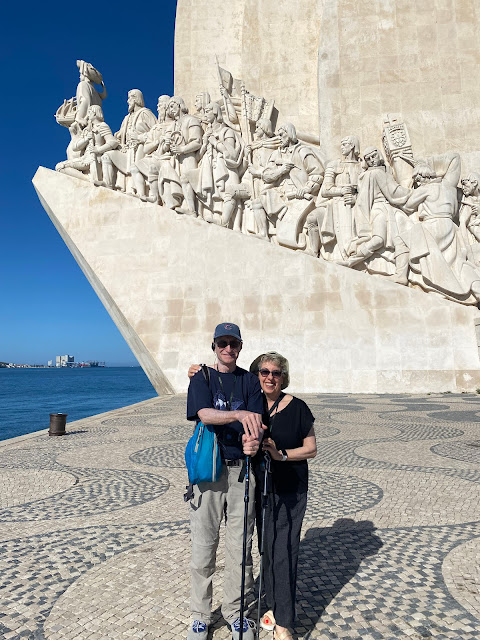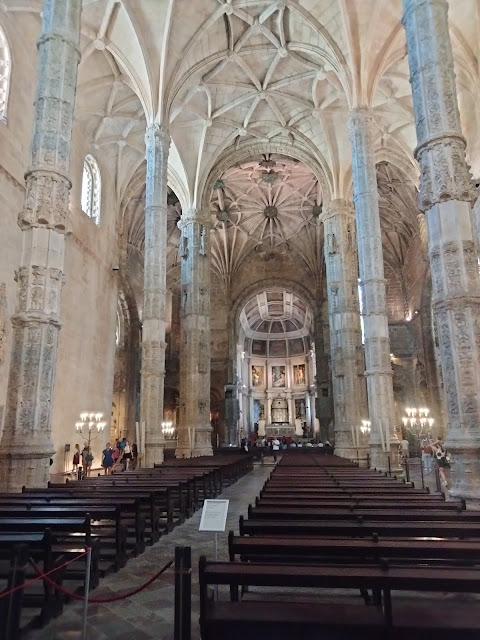Thursday, August 10, 2023
[dear readers, we are sending these blogs from the river boat; the internet service is not as robust as you might hope, so know that there will be a delay with these posts. thanks for understanding.]
Our first actual day of touring with the group! The buses headed out to the area we had dinner on Tuesday night. This is Belem (legend says this was shortened from "Bethlehem", the name given by Phoenicians who came to this area 1,000s of years ago), a district of Lisbon. This is a major cultural area, as it has several museums, monuments, a monastery, and Belem Palace - the official home of the President.
The first place we stopped was the Monument to the Discoveries. This is quite impressive! It is in the shape of a giant sail and was built to celebrate the 500th anniversary of the death of Henry the Navigator. It features 33 prominent people of that era. The detail on the figures is incredible.
There is also a giant map in the adjacent plaza that shows the location and date of all the places the Portuguese "discovered" and claimed (they had agreed with the Spanish to divide the world between them). You would really need to have a drone shooting from above to get the full map, but here is a section:
These days, this period is referred to as the "Time of Exploration", as the government has officially stated that they did not "discover" anything. This will come as quite a relief to the people who were living in India, western Africa, South America, etc. at the time.
Across the street is the National Coach Museum. Much to Wendy's disappointment, this was not a gigantic display of Coach purses and bags (nor did they have any in the gift shop; a major oversight!).
Rather this museum has the largest collection of coaches in the world (wait....didn't our guide in St. Petersburg tell us that about their collection?). These are the kind of coaches used in Cinderella; made for and used exclusively by the royalty. But we learned that they were a horrible way to travel, perhaps walking would have been better!. There were no springs to soften the often rutty or cobble-stoned roads, and the coaches had to travel pretty slowly. Thus the typical 8 hour ride to the coast mentioned previously.
They had coaches from the 17th - 19th century...gradually getting more ornate, and adding technical advances (such as being able to turn the front wheels, or a hole in the seat for the king to relieve himself!). Here are a few examples:
 |
| These are all made of carved wood! The one in the center has been restored to its original glory. |
Just down the street is the Monastery of St. Jerome. This was first built in the early 1500s and is another UNESCO World Heritage Site.
It contains the crypt of Vasco (who we now know is pronounced "Vashco") da Gama, the greatest of all the Portuguese explorers.
We've now seen both Vasco's and Christopher's resting places!
That actually ended the touring for the day (wayyyy too much time at the Coach Museum). The bus took us back to in the Praca dos Restauradores area of the city...a mostly touristy shopping area, but also residential. Gloria had recommended Casa do Alentejo for lunch. OMG! Check this out! It was originally a residence built in the 1600s! It was as impressive as any of the other palaces.
 |
| The inner courtyard, like those we saw in Morocco |
 |
| The dining room...more tiles |
And the food was also outstanding.
Wendy had the grilled Dory (cute little teeth and all) with vegetables and potatoes.
Before.....
Wayne had the fried cod on a bed of chickpea mash.
Both were delish but rather large portions for lunch!
Afterwards, we resumed our private Lisbon tour with Gloria.
We all know about the Spanish Inquisition in 1492. The Portuguese king, Manuel I, had no issue with the Jews (and, indeed, employed many Jews as advisors in different capacities) so many had resettled here. But the local Christians were not always as kind, so some Jews decided to leave and go elsewhere. The king realized that he was losing a lot of skilled people. So he sprinkled some water over a whole crowd and proclaimed them baptized as "New Christians"! They would be Christians in public (and would go to church), but remained Jewish in their homes. The New Christians even created a sausage made out of chicken so that the Old Christians would believe the New Christians were eating regular pork sausage.
Here is an example (top middle) from a current sausage shop:
This went on for a dozen years or so until 1506. The Old Christians decided the New Christians weren't being observant and reverent enough in church and so massacred several hundred of them. This tragedy preceded the Inquisition and Auto Da Fe in Portugal--so the Portugese were certainly not exempt from 16th c Anti-Semitism. To that point, between the deliberate destruction of the community and the earthquake afterwards, there are no actual traces that Jews lived here (except for a street sign and memorials). There is a Jewish community in Portugal today and we ran into a young man starting up a JCC--but certainly nothing significant.
In 2000, the Pope made a formal apology for all of the wrongdoings of the Church over the years, and said we should all treat everyone with respect and live together nicely.
In 2006, the Portuguese Jews created a monument on the 500th anniversary of the massacre:
We also learned the story of Aristides de Sousa Mendes, often called the "Oskar Schindler of Portugal", though in reality Mendes probably saved more Jews! There were no memorials or other public commemoration of his heroic deeds. Click here to learn more about him. He is honored in Yad Vashem as one of the Righteous Among Nations.
The major historical marker for the city is the Great Earthquake of 1755, which, along with the associated tsunami and fires (from all of the overturned candles and fireplaces), devastated the city and effectively ended the Golden Age of Portugal. Gloria mentioned that scientists predict that others will happen every 200 years or so. She said there was a smaller one in 1969, so we hope that that was the one for this cycle. This video gives an idea of what happened.
We then went to the Igreja de São Domingos, a church which is probably most famous for a fire which occurred there on August 13, 1959. Why so? Like Notre Dame in Paris, the fire pretty much destroyed the wooden roof, and did much damage to the interior. However, unlike N.D., here only the roof was replaced. The inside to this day still has major damage and charred, smoke-covered columns So it is a pretty eerie place.
Another ubiquitous icon of the city are the trolleys. Like in San Francisco, some of them are crammed with tourists (though these are run by overhead electric wires as opposed to cables). They are certainly a great way to travel if you have to go up any of the steeper hills, of which there are many. Since we had a nice air conditioned vehicle and a very savvy driver, we did not get the chance to actually ride a trolley, but did have some "up close and personal" interactions with trolleys and, as a result, some pix along the way.
Then Gloria took us to the highest point in the city for a fantastic view to the North, South, and West.
Walking around we came to a famous fabric store (where Wayne made a purchase) and the world's oldest bookstore (1732!), Livraria Bertrand. Note the tiled wall.
Finishing up at 6 pm, we both had hit the wall (the heat, the cobblestones up and down). So dinner was a shared chicken Caesar salad in the hotel bar!
Tomorrow we leave and head north. Wish we had more time to explore this fascinating city!
Love w&w.................




















No comments:
Post a Comment